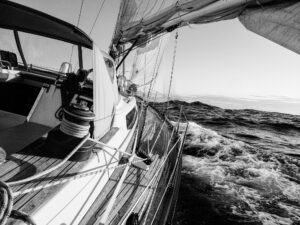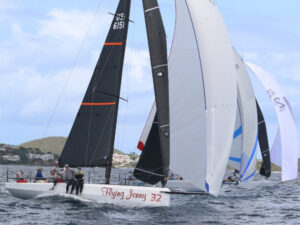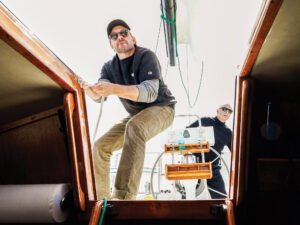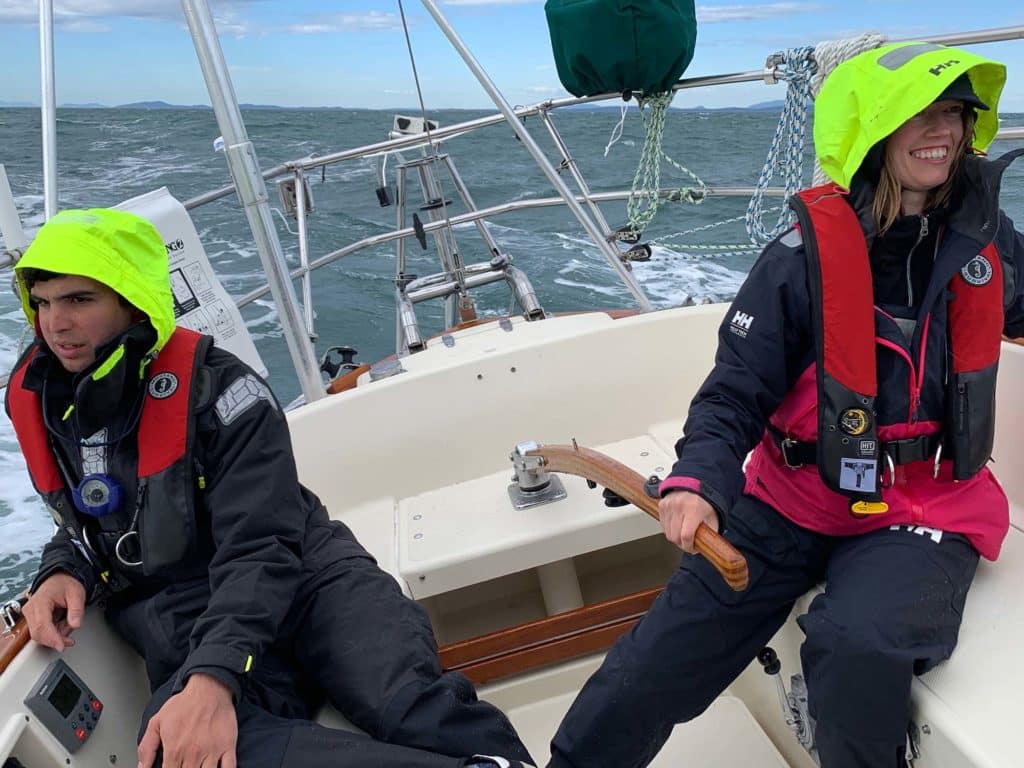
The nightmare scenario had begun 13 hours earlier. We’d rounded Cape Mendocino and were 60 miles from Bodega Bay, north of San Francisco. All four of our weather-forecast models agreed that we would have 15- to 25-knot winds with 6-foot waves every nine seconds—conditions that Ana María, our 1994 Pacific Seacraft 34, could handle, even on the south side of the infamous cape.
We had been at sea for seven days, and the sea state was worsening. Windspeeds were climbing higher and higher on the anemometer.
“Do you think we should take the mainsail down and sail only under the staysail?” my husband, Andrés, asked as we made dinner and prepared to start the watch schedule for the last night of the sail.
He was right to ask: We were seeing sustained 40-knot winds with 8-foot waves coming less than six seconds apart, with some waves coming from a different direction than the main swell. Ana María was overpowered, even with a second reef in the mainsail, so while she was surfing down these waves, she was by no means a comfortable ride. The force of each wave thrashed her hull. The waves were so steep that, during many of the rides down, her boom touched the water. We knew this posed a serious risk to the structural integrity of the rigging.
I agreed. If something went wrong in the middle of the night, Ana María would be much more manageable with only the staysail up.
We put on our foul-weather gear as we talked through the challenging procedure of the sail change, and double-checked each other’s tethers, ensuring that they were connected to our life jackets and the boat. We recalled the haunting words of famous sailors Lin and Larry Pardey, who advised that if you fall over, you die.
We encountered problems just dousing the genoa staysail, with the winds making a mess of all the sheets and furling lines. Anxiety started to build, as did the intensity. This was not going well.
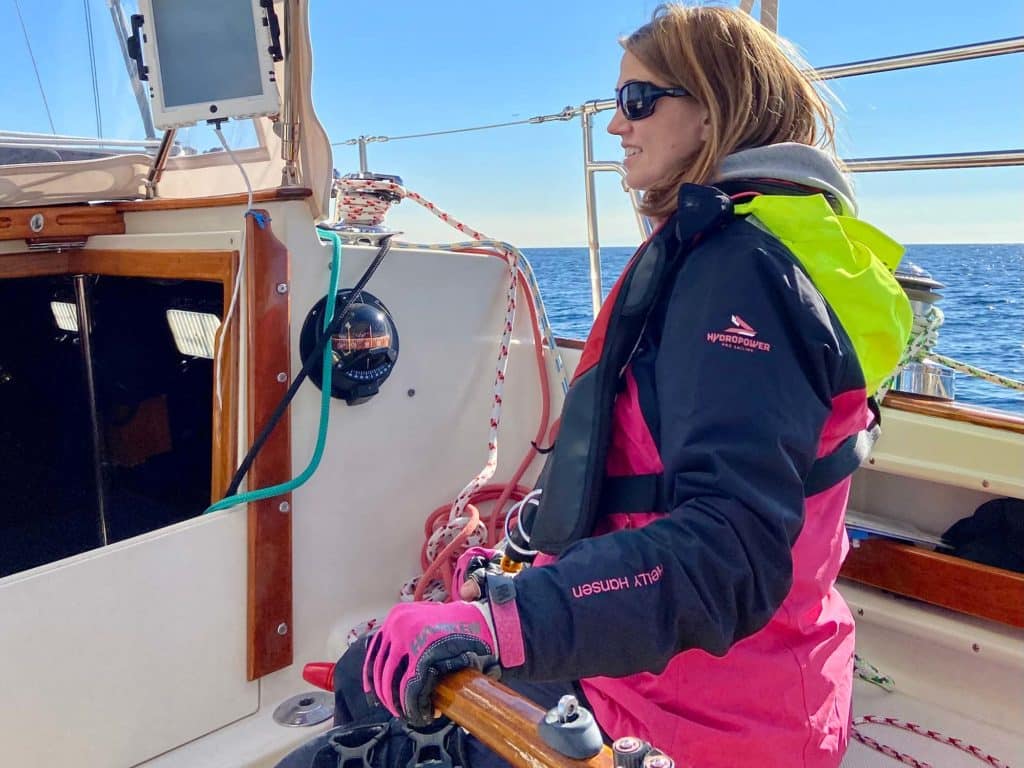
In spite of that, we were able to turn down to a beam reach just long enough to douse part of the mainsail, turning back up into the wind quickly to avoid catching a wave broadside to our beam. Andrés roughly flaked the sail and gathered it into sail ties, a feat of gymnastics while tethered to the webbing stretched across the boat.
Which meant that all we had left to do was attach the running backstay to keep the mast from pumping under the pressure of the staysail, and then reset the Monitor windvane to steer for us.
Watching Andrés clip in the running backstay, I was sure we’d made it through the worst part of the process. I had both hands on the tiller, trying to steer steadily across the onslaught of waves, when I turned my head to look over my shoulder.
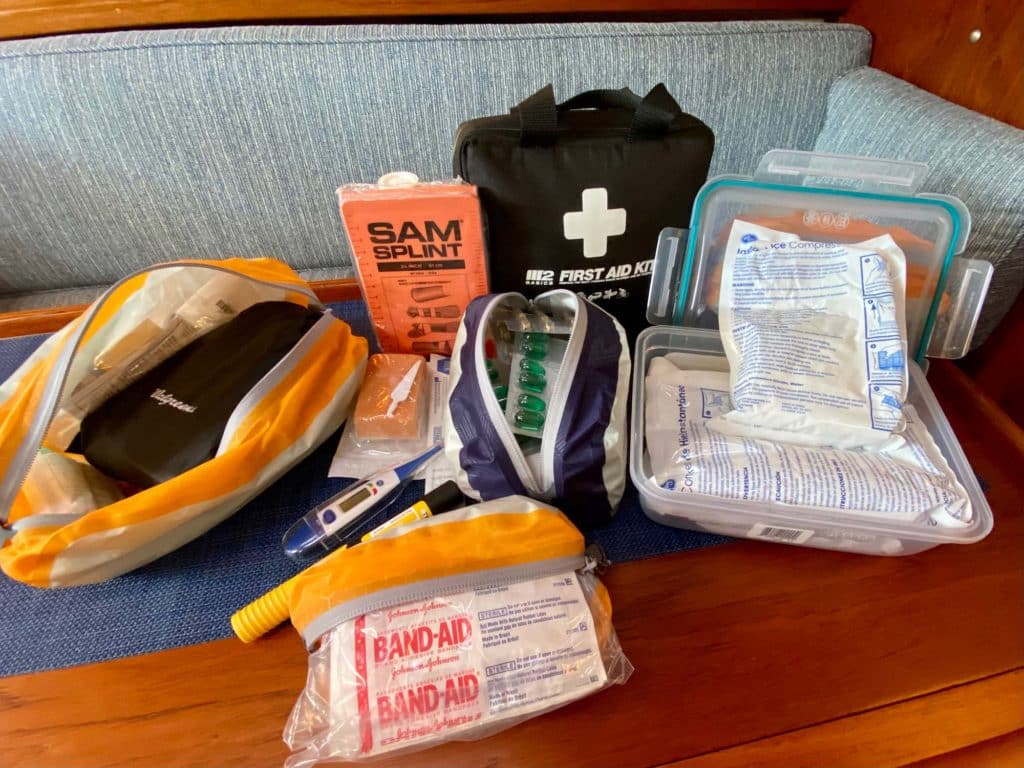
It was like a freeze frame in a movie, a slow-motion set of images I hope won’t haunt me my entire life: Behind my right shoulder was a wall of water coming toward us faster than I could comprehend.
Instinctively, I turned my back against the wave. When I opened my eyes, I saw Andrés, horizontal and in midair, supported only by the lifelines on the boat and inches away from disaster.
Then…black.
The first sensation I can recall was the burning feeling of salt water filling my sinuses. I was slammed against the other side of the boat as Andrés crawled back onto the side deck.
The tethers holding us to the boat did their jobs: We were still attached to the boat. We were still alive.
As the adrenaline began to wear off, my left knee throbbed and swelled to about three times its normal size. The wave must have slammed my joint straight into the cockpit’s sidewall.
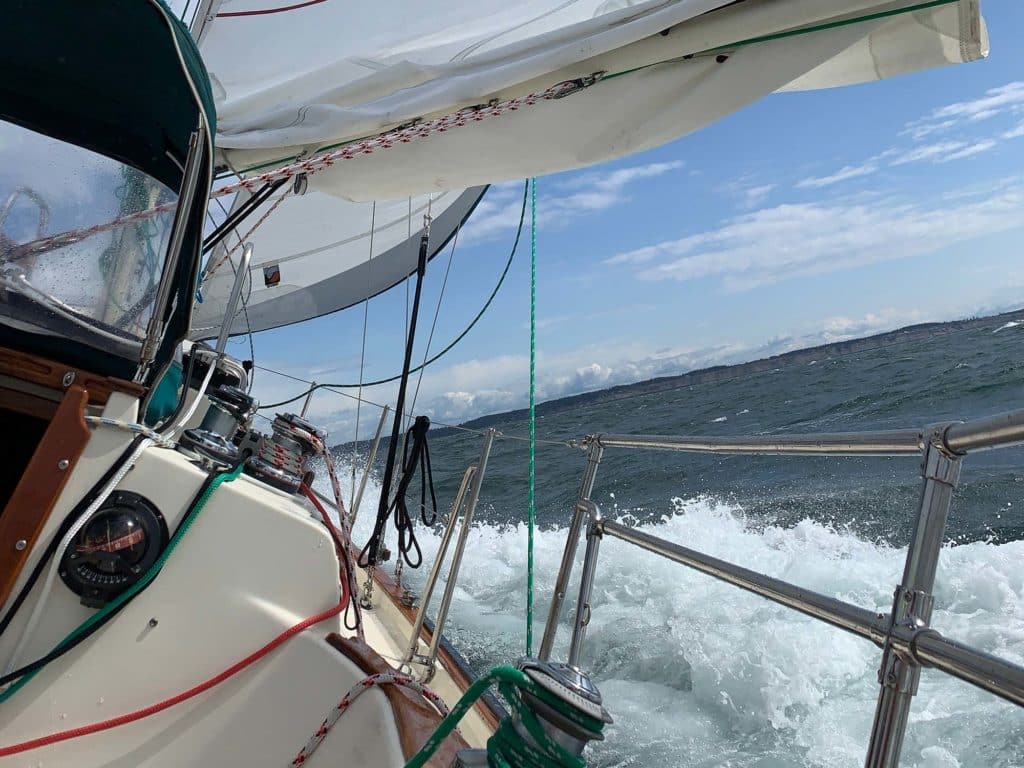
Andrés continued to put the boat back into order, keeping a close eye on the Monitor windvane’s performance against the assault of the waves. I headed below to fish an ice pack and ibuprofen out of our offshore first-aid kit. He stayed out there as long as he could, but the combined shock of the incident, mild hypothermia, and stress of the waves crashing over the stern again and again drove him inside. He huddled inside a thermal survival blanket for 30 minutes at a time.
Ana María, our wonderful sailboat, and “Paulita,” our self-steering Monitor windvane, sailed us safely and mostly independently throughout the night. As daybreak approached, even worse weather was forecast for the afternoon.
The tethers holding us to the boat did their jobs: We were still attached to the boat. We were still alive.
We had a decision to make: Do we sail or try to turn on the engine? Thanks to the wave, our engine was covered in salt water, and we knew that the control panel had been completely submerged.
After quick, desperate prayers—wonder of wonders, miracle of miracles—the engine control panel turned on, and our diesel engine started to crank. We listened carefully for it to stall, knowing that the fuel lines could be full of salt water, but instead, it ran well for several minutes.
Our best chance at beating the approaching gale was to motor to the next harbor. Since Andrés had been up most of the night and would be the one to steer us in close quarters, we decided that I would steer for the next four hours while he slept. My leg, at that point the size of a cantaloupe, would be propped up in the cockpit.
In the morning light, I eagerly looked for the coastline and processed our predicament. Ana María was stable, sailing reliably. Her crew, though a bit worse for the wear, didn’t seem to be in immediate danger. But, I thought, maybe someone could get a hold of the marina for us? Let the dock staff know to hold a spot for us so we could get to a hospital right away?
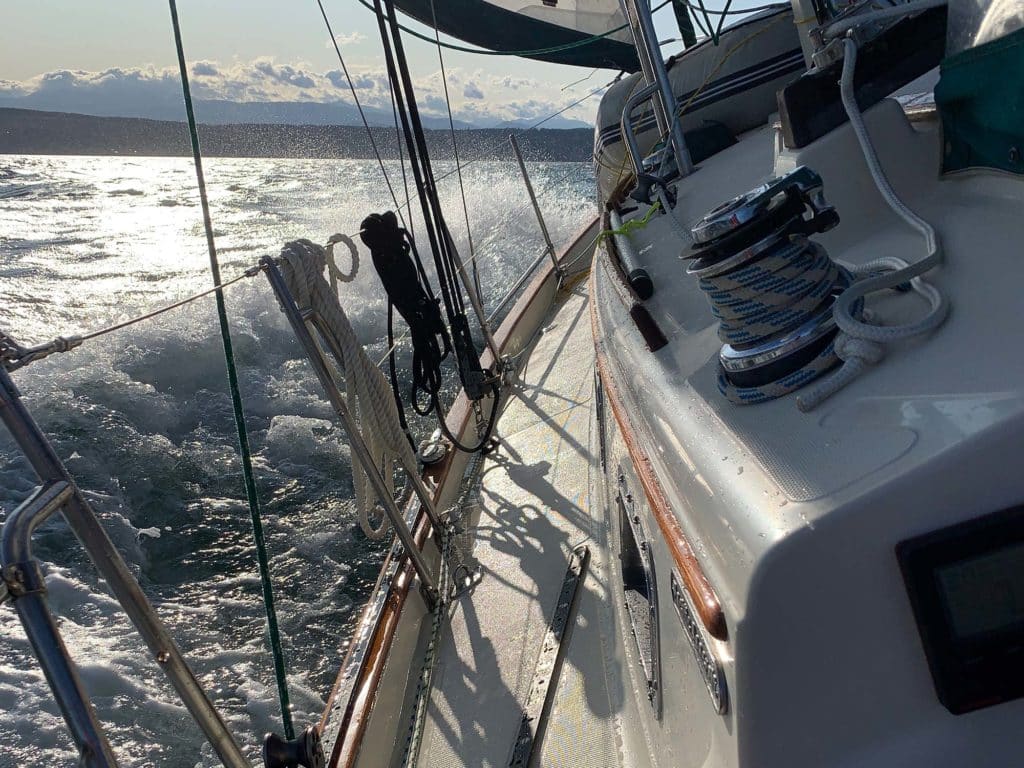
I called the local US Coast Guard station and was ready with answers to their questions. I gave them our name, position and estimated arrival time, and said: “We caught a wave in the cockpit off the coast of Cape Mendocino, and we suspect one of our crew has a broken leg. We need assistance coordinating with a marina for our arrival and possibly help docking. There are two adult crewmembers on board, both wearing life jackets.”
To our relief, the Coast Guard made arrangements for us at the marina, and patched me through to a medical professional, who confirmed that we were triaging the knee injury correctly. We turned down the offer for rescue at sea, so the station tracked our progress and asked each hour, “Are you still comfortable navigating in the current conditions?”
We were mighty glad and surprised to see the Coast Guard ship at the harbor entrance buoy, waiting to escort us in. We docked at the marina with the help from two Coasties who kindly carried me off the boat and straight into a taxi.
We celebrated our arrival in California at the emergency room with a cocktail of painkillers and an X-ray that showed a broken kneecap and questionable quad tendon. And we asked ourselves, How can we get back on our boat?
Andres and I lived on Ana Maria. We had dreamed of cruising the world in our sailboat for years. We’d worked for it. We’d saved for it. But how could we move past the trauma of that night?
Then I remembered a tool often used in my former career: the after-action review, a postmortem that the US Army uses to document lessons learned and areas that need improvement.
To start, we asked ourselves three questions: What went well and why? What went wrong and why? What should we do next time and why?
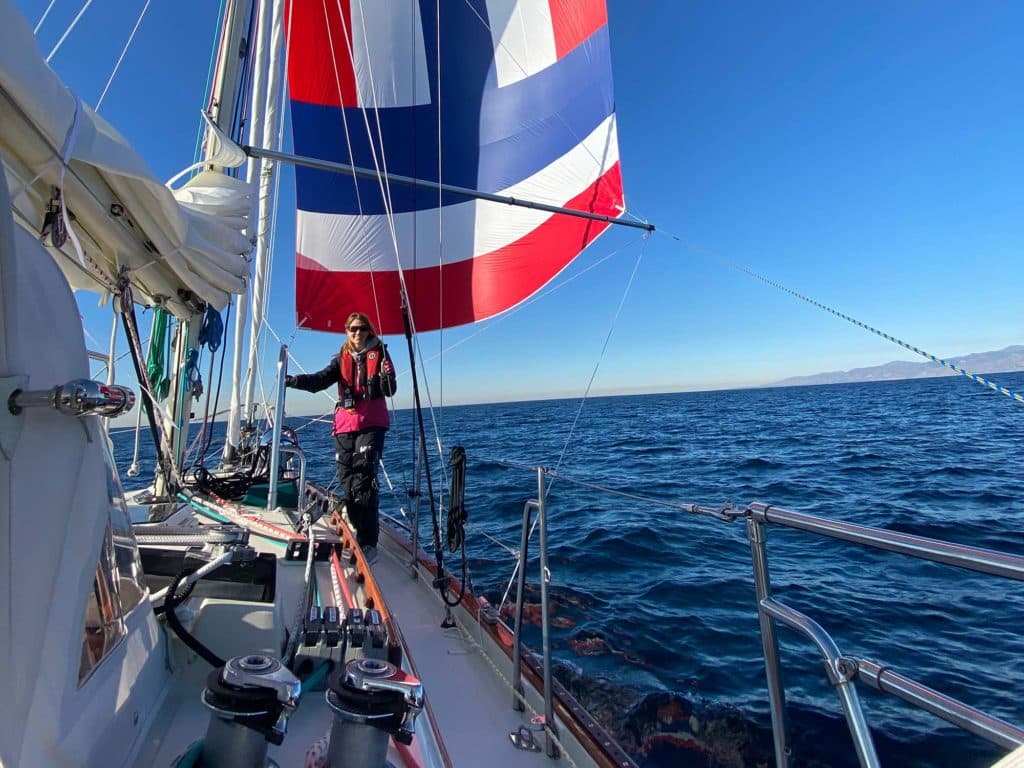
We challenged ourselves to go deep on the why, asking the questions in layers so we could move from identifying symptoms to identifying root causes. Our discussion sounded something like this: “What went wrong? The headsail sheets got tangled. Why? Katherine couldn’t hold the staysail sheet tightly enough. Why? We were relying on her bare strength to hold the sail against 40 knots of wind. Why? We’re handling three lines at once but have only two winches on that side. Why? We are short one winch when on a starboard tack.”
It was only after asking the fourth why that we realized being short winches on the starboard tack was the real problem. We needed a configuration where we could have all three lines held by winches in heavy-weather headsail changes.
We asked ourselves three questions: What went well and why? What went wrong and why? What should we do next time and why?
Identifying root causes was a mental challenge, but the discussion itself proved to be an emotional challenge. Andres and I brainstormed our responses separately before coming together to discuss them. It was damn hard for me to write: “We took a wave in the cockpit. Why? Because, when I was at the helm, I let the boat go broadside to a wave.” It was even harder to say it aloud to my husband, but the declaration lit a fire in me to improve my hand-steering in heavy seas.
Together, we’ve taken ownership of the solution: We are committed to finding opportunities for me to build this skill, and my husband is committed to coaching me as I learn.
We also ran our after-action review by a rigger friend who understands more about ocean passages than anyone else we know. He assured us that we weren’t completely stupid and affirmed our findings: “If I were you, I would have also tried to eliminate the boom from the equation in those seas.” He built our competence with ideas we hadn’t thought of but will try next time.
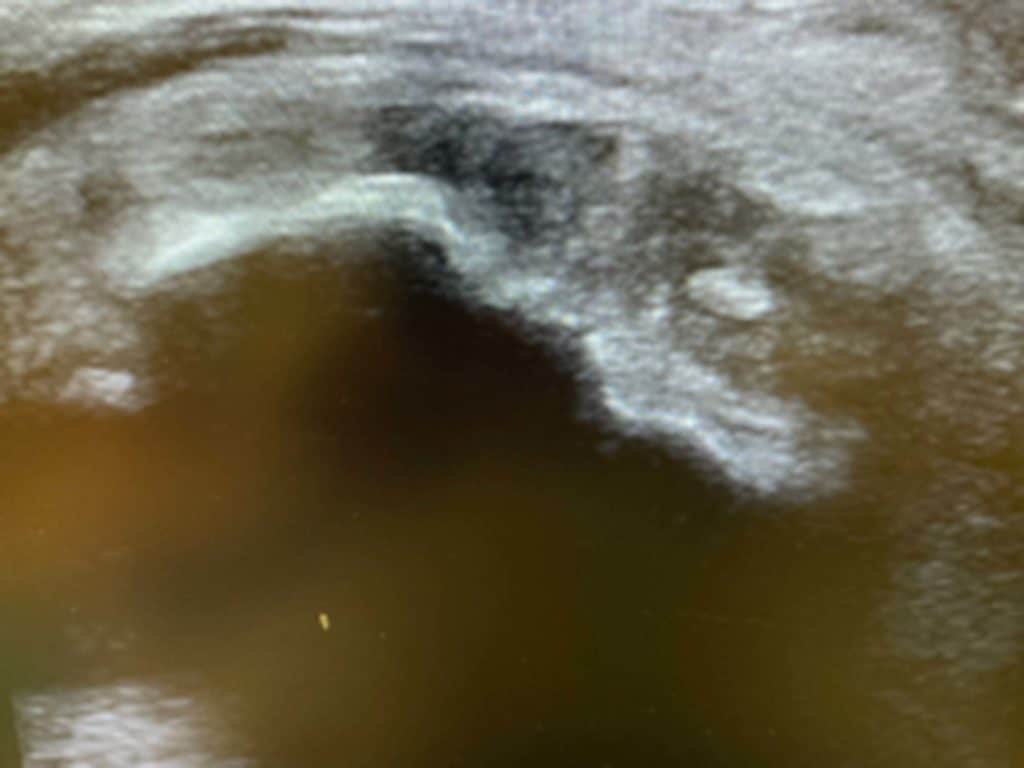
We returned to the boat, but before we cast off again, we implemented what we had learned, taking the time to ensure that we could keep doing the right things and change what was wrong. We immediately found replacement ice packs for our first-aid kit because they had kept the knee swelling at bay and allowed me to steer during the emergency. As soon as we washed the boat, we took two hours to find a configuration of three lines on three winches so that we won’t ever find ourselves again untangling the headsail sheets at the most inopportune time.
Eight weeks later, we were surfing 8-foot waves in 20-knot winds off the coast of central California. “This feels less like sailing and more like skiing moguls,” Andrés said. We jibed a couple of times in daylight before I went down to sleep and he stayed in the cockpit for the first night watch.
His voice cut through my dreams: “Katherine, it’s time to jibe.”
I pulled on my foul-weather gear and tether. By the time I had climbed into the cockpit, the anxiety that had been simmering all day came to full boil. This wasn’t exactly the maneuver we were performing when I broke my knee, but it involved the same skills. I would need to hand-steer without being able to see the angle of the waves crashing behind me.
As I disengaged the windvane, my mouth was as dry as a desert. He brought the boom to center, and I headed downwind to bring the stern through the wind.
Boom! We heard and felt the weight of the sails slam to the opposite side of the boat. He let out the main sheet as quickly as possible, as I found the new rhythm of the seas on this tack. He jibed the genoa and reengaged the windvane.
With the preventer rerigged, the most stressful part of the night, the activity I had been dreading for weeks, was finished. We had done it safely.
And so we shall again, hopefully for many years to come.
Follow Katherine Gonzalez aboard sailing vessel Ana María at cocaptainslog.com or on Instagram @cocaptainslog

